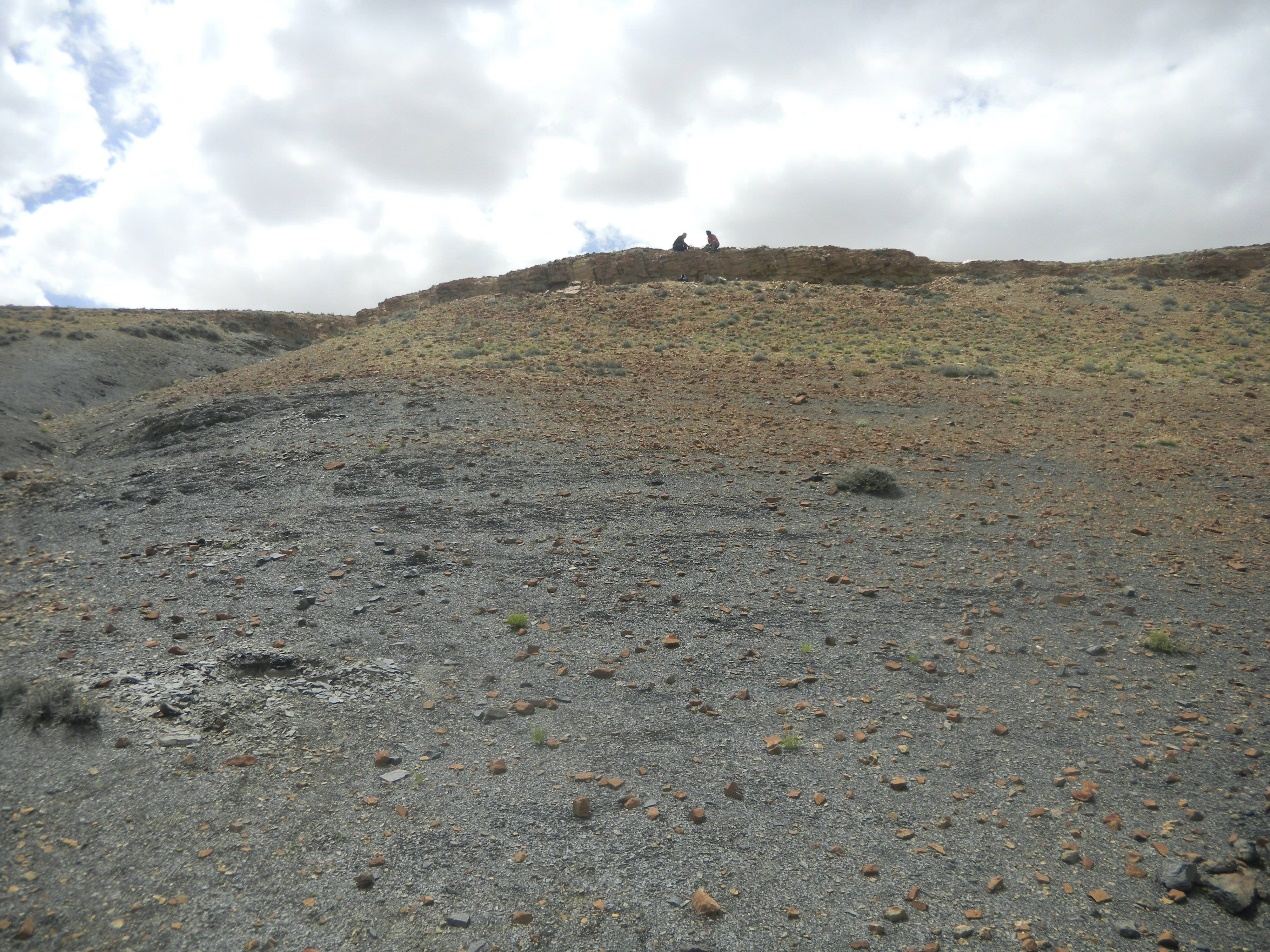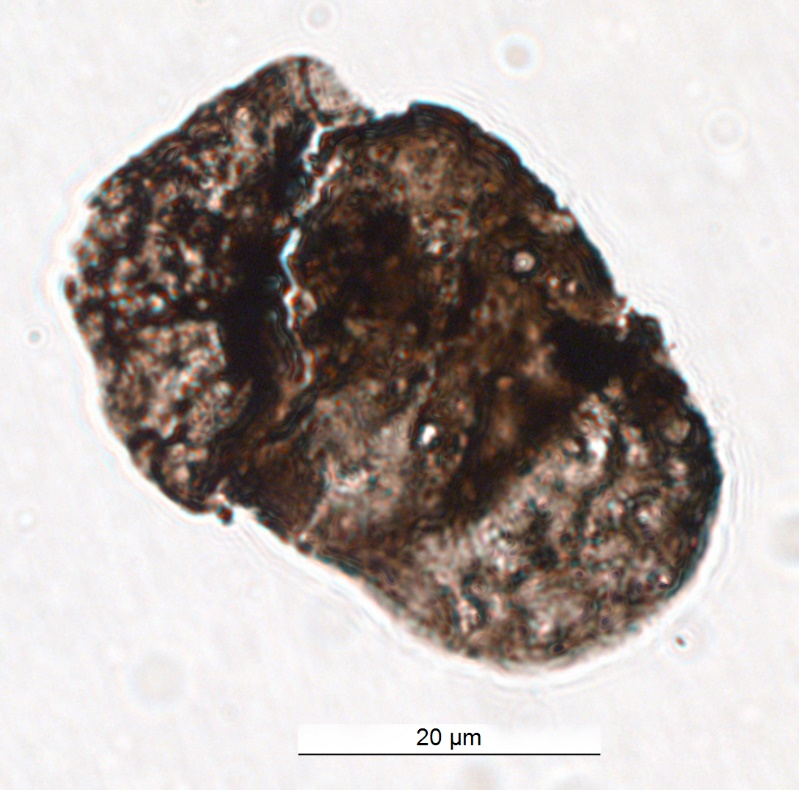Increased ultraviolet radiation during the Permian extinction? Evidence of "sunscreen" in fossil pollen grains
The extinction at the end of Permian 252 million years ago caused the extinction of about 81% marine species and 89% terrestrial species. The main reason is believed to be the environmental change caused by large-scale volcanic eruption, but there is still no direct evidence that environmental factors affect terrestrial ecosystems. In cooperation with foreign counterparts, researchers in China discovered the direct evidence that the destruction of the ozone layer led to the extinction of terrestrial life at the end of Permian by studying the changes of "sunscreen" content in fossil pollen grains during this period.
The research results were published online in the internationally renowned journal Science Advances on January 6, 2023.

Black shale at the end of Permian in Qubu section of southern Tibet. Photo courtesy of Nanjing Institute of Geology and Paleontology, CAS

Pollen fossils found in Permian-Triassic transitional strata in Qubu section. Photo courtesy of Nanjing Institute of Geology and Paleontology, CAS
Volcanic eruption led to mass extinction of land? There was a lack of direct evidence
The extinction event at the end of Permian was the largest extinction event in Phanerozoic. Scientists generally believe that the increase of global greenhouse gases caused by the eruption of Siberian igneous province at the end of Permian, global warming and ocean acidification may be the main causes of this extinction. However, there are still many debates about how these environmental factors affect terrestrial ecosystems.
Some palynologists have found some deformed spores and pollen in the continental Permian-Triassic transition section. It is speculated that these deformed spores or pollen may be caused by the increase of ultraviolet radiation induced by the destruction of the global ozone layer caused by halogen elements ejected from the Siberian igneous province. However, the study of abnormal spores and pollen produced in modern plants shows that the environmental background of these abnormal pollen and spores is very complicated, and drought, air pollution and plant trauma may all induce abnormal spores or pollen to be produced in plants. Therefore, the discovery of a small number of abnormal spores and pollen in the continental Permian-Triassic transition section cannot directly prove that there was an increase in ultraviolet radiation caused by the global ozone hole during the extinction at the end of Permian.
Using the content of "sunscreen" to deduce the intensity of atmospheric ultraviolet radiation
Plants need sunlight for photosynthesis to provide energy for plant growth, but at the same time, it is necessary to avoid the damage of harmful ultraviolet rays in sunlight to genetic information in plants, especially in plant reproductive cells (spores and pollen). In order to adapt to the terrestrial radiation environment, terrestrial plants have evolved some regulatory mechanisms to reduce the damage of ultraviolet rays to plants. In the germ cells of plants, this mechanism is manifested in that there are a large number of compounds-coumaric acid and ferulic acid-in the outer walls of plant spores and pollen, which are very similar in function to "sunscreen cream". These compounds can form resonance-stable phenol free radicals and resist the oxidation caused by ultraviolet rays, thus protecting fragile spores and pollen and providing guarantee for the spread and reproduction of terrestrial plants.
Modern botanists have observed that plants can automatically adjust the content of "sunscreen" on the outer wall of their germ cells according to the surrounding ultraviolet radiation environment, and these "sunscreen" can be stored in the outer wall of inert spores and pollen for a long time. Therefore, in theory, researchers can determine the content of "sunscreen" in these spores and pollen, and deduce the intensity of atmospheric ultraviolet radiation in geological history.
"Sunscreen" is difficult to digest and has low nutrition, or leads to the extinction of insects.
According to Liu Feng, a researcher at Nanjing Institute of Geology and Paleontology, Chinese Academy of Sciences, the research team quantitatively measured coumaric acid and ferulic acid in 1011 pollen grains from Permian-Triassic transition section in southern Tibet, China. Through the big data analysis of infrared spectra produced by these pollen, the research team found that during the extinction at the end of Permian, the contents of coumaric acid and ferulic acid in the outer wall of pollen in the stratum were significantly higher than those in fossil pollen before and after extinction, which directly proved that there was an increase in global ultraviolet radiation during the extinction at the end of Permian.
The increase of ultraviolet radiation in the air has a far-reaching impact on the whole terrestrial ecosystem. Because ultraviolet rays not only have a strong killing effect on plant germ cells, but also cause damage to plant mesophyll cells. In order to resist the damage of ultraviolet rays to mesophyll cells, plants will synthesize lutein, coumaric acid and ferulic acid in their leaves, which will reduce the synthesis of chlorophyll accordingly, leading to the weakening of photosynthesis of plants, which will further weaken the absorption capacity of plants for greenhouse gases, further aggravating the global greenhouse gas increase caused by volcanic eruption at the end of Permian.
In addition, lutein, coumaric acid and ferulic acid in mesophyll are compounds that are difficult to digest and have low nutritional value for herbivores and insects, so the increase of ultraviolet radiation indirectly affects the terrestrial food chain, which may be the main reason for the extinction of terrestrial herbivores and insects at the end of Permian.
Beijing News reporter Zhang Lu
Editor Liu Qianxian proofreads Wu Xingfa.